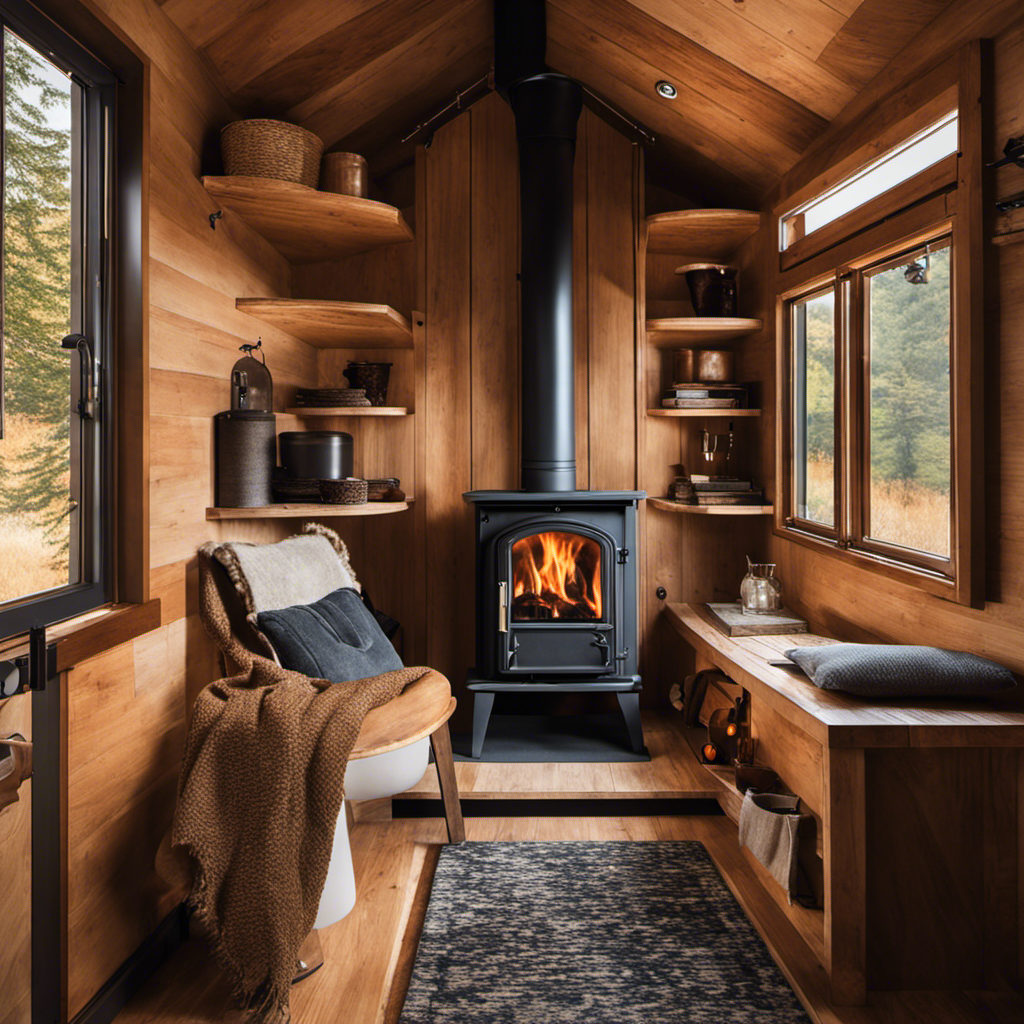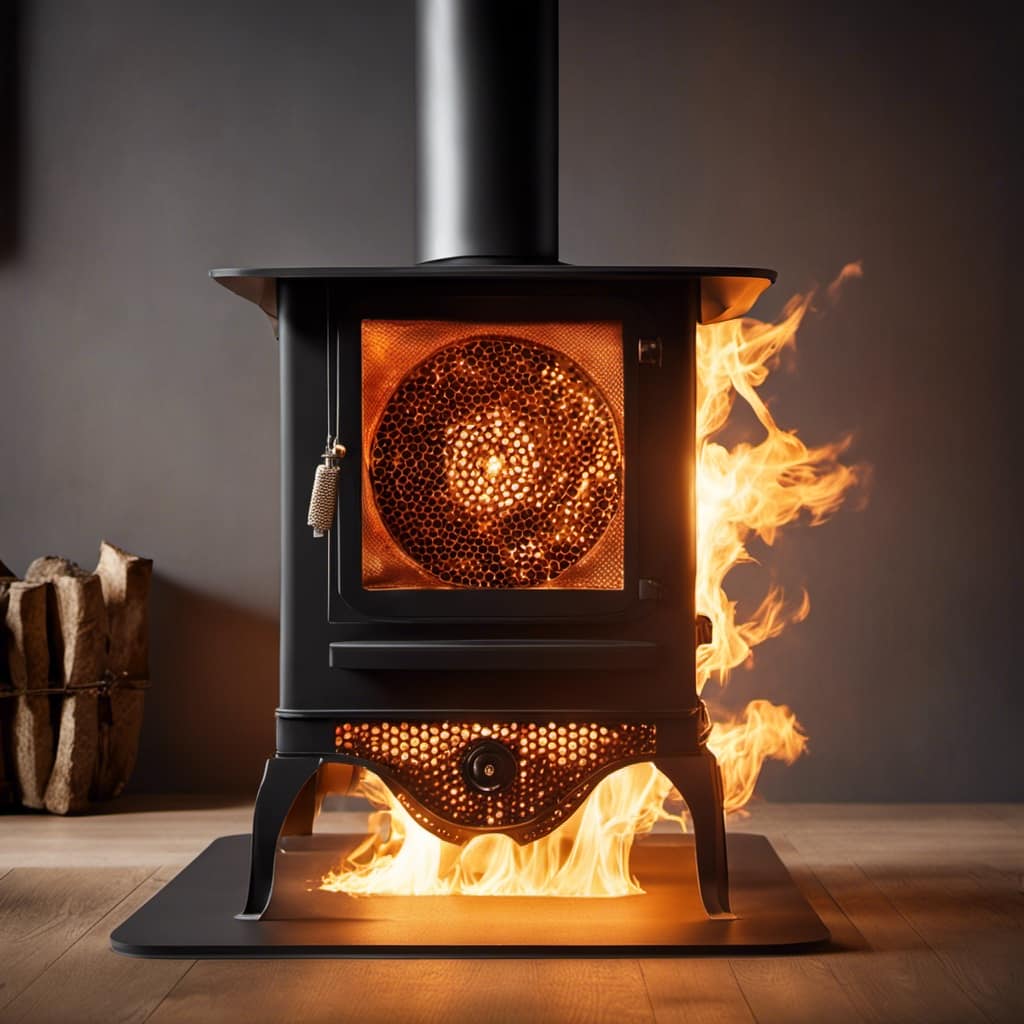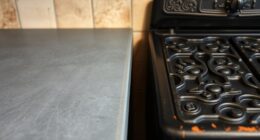As someone who owns a wood stove, I understand the difficulties in maintaining a spotless and transparent glass door. However, worry no more, for I have discovered several reliable techniques that will get your glass sparkling quickly.
From a simple vinegar and water solution to a lemon juice and salt mixture, I’ll share the best ways to tackle the grime.
So put on your cleaning gloves and let’s dive into the world of glass cleaning solutions for your wood stove.
Key Takeaways
- Homemade cleaning solutions like vinegar and water, baking soda paste, and lemon juice and salt mixture can effectively clean glass on a wood stove.
- Homemade cleaning solutions are natural, eco-friendly, and safer for the environment and health.
- Commercial glass cleaners are a convenient and effective option specifically formulated to cut through tough stains and residue on glass surfaces.
- Using the right cleaning tools like microfiber cloth or newspaper is crucial for achieving a streak-free finish when cleaning glass on a wood stove.
Vinegar and Water Solution
I love using a vinegar and water solution to clean the glass on my wood stove. There are several pros to using vinegar for this purpose.
First, vinegar is a natural and eco-friendly cleaner, making it a safer option than harsh chemical cleaners.
Additionally, vinegar is effective at removing dirt, grime, and soot from the glass, leaving it sparkling clean.
However, there are a few cons to consider. Vinegar has a strong smell that some people may find unpleasant. It also requires a bit more effort and scrubbing to remove stubborn stains compared to stronger chemical cleaners.
To effectively remove stubborn stains using a vinegar and water solution, simply mix equal parts vinegar and water in a spray bottle.
Spray the solution onto the glass and let it sit for a few minutes. Then, use a soft cloth or sponge to scrub away the stains.
Rinse the glass with clean water and dry with a microfiber cloth for a streak-free finish.
Commercial Glass Cleaner
Using a commercial glass cleaner is a convenient and effective way to keep my wood stove’s glass clean and clear. While there are alternative cleaning methods and homemade glass cleaner recipes available, I find that a commercial glass cleaner provides the best results. These cleaners are specifically formulated to cut through tough stains and residue without damaging the glass surface. They’re also convenient to use, as they come in ready-to-use spray bottles.
I simply spray the cleaner onto the glass, let it sit for a few minutes, and then wipe it clean with a soft cloth. The commercial glass cleaner leaves my wood stove’s glass sparkling and free from streaks.
However, if you prefer a more natural approach, you can try using a baking soda paste, which I’ll discuss in the next section.
Baking Soda Paste
The baking soda paste effectively removes tough stains and residue from the glass surface without causing any damage.
When it comes to cleaning glass on a wood stove, there are alternative options to traditional commercial glass cleaners. Natural cleaning methods can be just as effective, if not more so, while also being safer for both the environment and your health.
Baking soda is a versatile cleaning agent that can be used in a paste form to tackle stubborn stains on glass surfaces. To create the paste, simply mix baking soda with a small amount of water until it forms a thick consistency. Apply the paste onto the glass and gently scrub using a non-abrasive sponge or cloth. Rinse thoroughly with water and wipe dry.
Now, let’s move on to another natural cleaning method: the lemon juice and salt mixture.
Lemon Juice and Salt Mixture
I love using the lemon juice and salt mixture to clean glass surfaces because it effectively cuts through grease and grime. It’s one of my go-to homemade cleaning solutions that I use regularly. The acidity of the lemon juice helps break down the dirt, while the abrasive texture of the salt provides scrubbing power. Together, they make a natural cleaning method that is not only effective but also safe for the environment.
Here is a visual representation of the benefits of the lemon juice and salt mixture:
| Benefits | Lemon Juice and Salt Mixture |
|---|---|
| Effectiveness | Cuts through grease and grime |
| Natural | No harmful chemicals involved |
| Cost-effective | Ingredients are easily available and inexpensive |
| Eco-friendly | Safe for the environment |
| Versatile | Can be used for various cleaning tasks |
Overall, the lemon juice and salt mixture is a fantastic option for anyone looking for a natural and effective way to clean glass surfaces.
Newspaper or Microfiber Cloth
I prefer using a microfiber cloth instead of newspaper because it leaves fewer streaks and is more absorbent. When it comes to cleaning glass, using the right tools is crucial to achieve a spotless finish. Here are four reasons why I believe microfiber cloths are superior to newspaper:
-
Streak-free shine: Unlike newspaper, microfiber cloths are designed to pick up and trap dirt, dust, and grime without leaving any streaks behind. This ensures a crystal-clear view through the glass.
-
Absorbency: Microfiber cloths have tiny fibers that can absorb a significant amount of liquid. This makes them perfect for tackling tough stains or spills on glass surfaces, as they can quickly soak up moisture, leaving the glass dry and shiny.
-
Gentle on glass: Newspaper can sometimes leave scratches on glass surfaces due to the ink and rough texture. Microfiber cloths, on the other hand, are soft and gentle, making them safe to use on delicate glass without causing any damage.
-
Reusability: Microfiber cloths are reusable, which means you can wash and reuse them multiple times. This not only saves money in the long run but also reduces waste compared to constantly buying newspapers.
Frequently Asked Questions
Can I Use a Regular Household Glass Cleaner on My Wood Stove’s Glass?
I wouldn’t recommend using a regular household glass cleaner on your wood stove’s glass. It’s best to use alternative cleaners specifically designed for wood stove glass to ensure safe and effective cleaning.
Is It Safe to Apply Lemon Juice Directly on the Glass Surface?
It is not recommended to apply lemon juice directly on the glass surface of a wood stove. Lemon juice can have corrosive effects on the glass. There are alternative glass cleaners available that are safe to use.
Can I Use a Mixture of Vinegar and Baking Soda Instead of a Commercial Glass Cleaner?
Yes, you can use a mixture of vinegar and baking soda as an alternative to a commercial glass cleaner. It is a natural and effective option that has the added benefits of being non-toxic and environmentally friendly.
Will Using a Newspaper to Clean the Glass Leave Any Residue or Streaks?
Using a newspaper to clean the glass on a wood stove can leave residue and streaks. It’s important to use a proper glass cleaner to ensure safety and effectiveness. Lemon juice or a mixture of vinegar and baking soda can also be effective. Regular cleaning is key to maintaining clarity.
How Often Should I Clean the Glass on My Wood Stove to Maintain Its Clarity and Effectiveness?
To prevent glass on wood stoves from getting dirty, it’s important to clean it regularly. I find that cleaning it every week or so helps maintain its clarity and effectiveness. Following best practices for maintaining the glass on a wood stove is key.
Conclusion
After exploring different cleaning options, it’s clear that there are several effective ways to clean the glass on a wood stove. Whether it’s using a vinegar and water solution, a commercial glass cleaner, a baking soda paste, or a lemon juice and salt mixture, each method has its own benefits.
By using these techniques, you can easily achieve a spotless and clear glass on your wood stove, enhancing the overall appearance and efficiency of your stove.
Growing up surrounded by the vast beauty of nature, Sierra was always drawn to the call of the wild. While others sought the comfort of the familiar, she ventured out, embracing the unpredictable and finding stories in the heartbeat of nature.
At the epicenter of every remarkable venture lies a dynamic team—a fusion of diverse talents, visions, and passions. The essence of Best Small Wood Stoves is crafted and refined by such a trio: Sierra, Logan, and Terra. Their collective expertise has transformed the platform into a leading authority on small wood stoves, radiating warmth and knowledge in equal measure.











